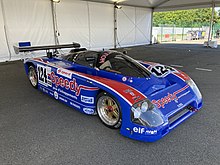Racing car model
Argo JM19[1]![]() JM19D |
| Category | IMSA GTP Lights/Group C2 |
|---|
| Constructor | Argo Racing Cars |
|---|
| Designer(s) | Jo Marquart
Achim Storz |
|---|
|
| Chassis | Aluminum honeycomb monocoque covered in carbon fiber composite body |
|---|
| Suspension | Double wishbones, coil springs over shock absorbers, anti-roll bar |
|---|
| Length | 4,670 mm (183.9 in) |
|---|
| Width | 1,920 mm (75.6 in) |
|---|
| Height | 1,100 mm (43.3 in) |
|---|
| Axle track | 1,480 mm (58.3 in) (front)
1,470 mm (57.9 in) (rear) |
|---|
| Wheelbase | 2,670 mm (105.1 in) |
|---|
| Engine | Mazda/Buick/Ferrari/Ford-Cosworth 1.3–4.4 L (79.3–268.5 cu in) 2-rotor/V6/V8, naturally-aspirated, mid-engined |
|---|
| Transmission | Hewland DGB 5-speed manual |
|---|
| Power | 330–465 hp (246–347 kW) |
|---|
| Weight | 700 kg (1,543.2 lb) |
|---|
|
|
 Argo JM19-Buick IMSA GTP Lights car at the 1987 Miami Grand Prix
Argo JM19-Buick IMSA GTP Lights car at the 1987 Miami Grand Prix
 JM19C at the 2022 Le Mans Classic
JM19C at the 2022 Le Mans Classic
The Argo JM19, and its derivatives/evolutions, the Argo JM19C, and the Argo JM19D, are a series of IMSA GTP Lights/Group C2 sports prototype, designed, developed, and built by British constructor Argo Racing Cars, for the IMSA GT Championship, introduced in 1985.[2] Its use in sports car racing continued into the early 1990s. It won a total of 7 races, and scored a total of 21 podium finishes. It was powered by a number of different engines, including a Mazda 13B rotary engine, a Buick V6 turbo engine,[3] a Ferrari V8 engine, and even a Ford-Cosworth DFL V8 Formula One-derived engine.[4] It did, however, find most of its success when equipped with the Mazda-powered Wankel rotary engines.[5][6][7][8][9]
References